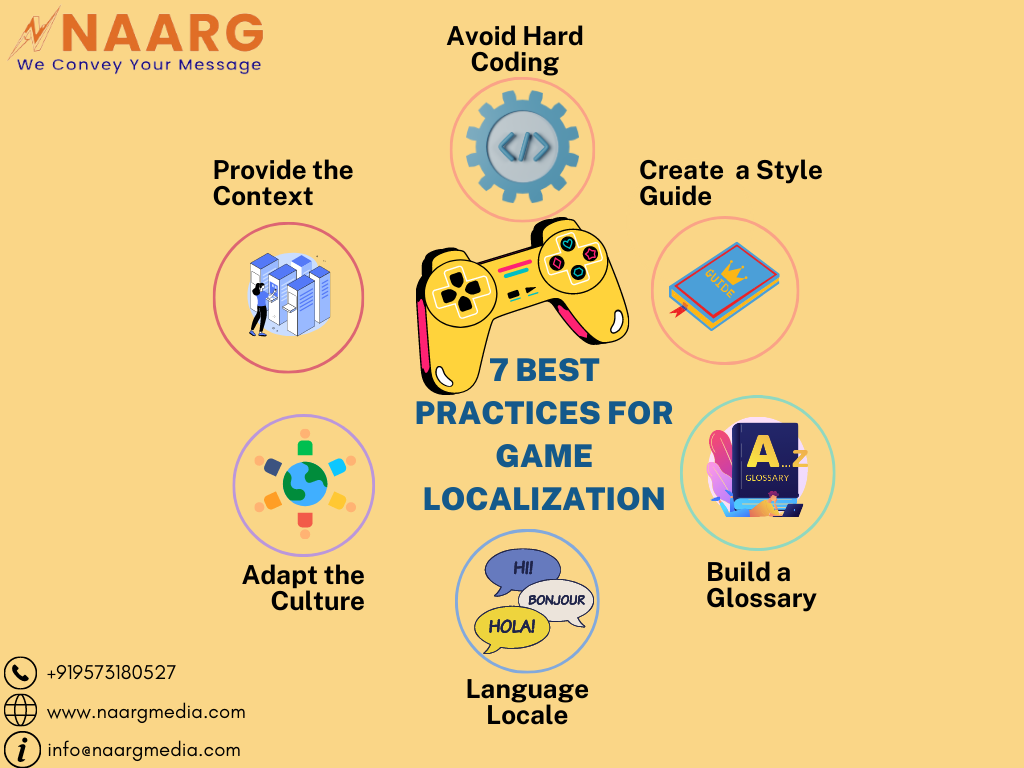Game localization has become an essential part of our modern gaming industry. A recent report stated that 25% of the consumer market for gaming is English-speaking and the rest of the consumer market is non-English speaking.
This reason is enough for localizing games and reaching target audiences to boost sales and market share. The game localization process may seem easy but achieving a fully localized game requires dedicated resources and efforts.
In this blog, we have listed seven best practices for game localization that will provide insights into ways to adapt the game localization process for the target audience.

What are the parts of the game localization?
The game localization process involves a process of adapting video games and localizing games for different regions, languages, and cultures. The parts of the game localization include-
1. Translation
This involves translating the text and dialogues into different languages. It also includes translating menus, subtitles, character dialogue, item descriptions, and other text that appears in the Game localization process.
2. Audio Localization
This involves recording and editing voiceovers for characters, sound effects, and music. Audio localization is especially essential for games with narrative elements.
3. Cultural Adaptation
It involves adapting the games’ content to the cultural norms and sensitivities of the target audience. For instance- some games may need to be localized to comply with regional laws, social norms, or religious beliefs.
4. User interface localization
It involves adapting the game’s user interface to different language locales and cultural preferences. It includes adapting the font, layout, and other graphical elements to ensure that they are easy to read and understand in different languages.
5. Quality Assurance
It involves testing the localized versions of the game to ensure that it works correctly and that all translations are accurate and appropriate.
These are all the parts of the game localization process. The specific requirement and game localization process might vary depending on the game and the target audience.
Seven Best Practices for Game Localization
When managing a game localization process, there are resources that you need to know and equip your translators, localizers, and game developers to help them better understand the game content and ensure the success of your game localization project. The global gaming industry is increasing exponentially.
This fact not only ensures the rise of the gaming industry but also the fact that video game localization will become an utmost necessity in the coming years.
Here we have listed the seven best practices for game localization to help everyone in the game localization project.

1. Avoid Hard- coding
Hard coding is a nightmare for localizers. Hard coding should be avoided because it increases the risks of lines that get overlooked and should have gotten translated. It increases an extra job for the localizer because the localizer must know the code and source language to avoid messing up the localization process. The use of external resource files like .xml or .po format is done to avoid hard coding and store all the game content and elements that need to be localized.
2. Create a Style Guide
Style Guide is a framework for understanding the game’s content. It acts as a prototype for the translator so they can easily refer to the Style guides for translations. A detailed style guide helps the translator and they can smoothly adapt the game’s content and language tone of the game. Brand Elements, Linguistics, Formatting, and Grammar are required when creating style guides. In brand elements, the language tone and identity are considered. For Linguistics, the structure and style of the game language are considered. In Formatting and Grammar the font and style of the game’s content are considered.
3. Build a Glossary
Glossary is a standard requirement for any localization project. It ensures consistency across the game developers and game localization process team. To build a Glossary the essential point is to keep it simple and only include terms that get used in the game. Always make sure that game-specific terminology gets translated in the same way. Providing context for all the terminologies in the glossary is also essential. Context can be in any form visual context, verbal description, or sample translations.
4. Adapt the Culture
It is a crucial part of any localization project. Many aspects are there to be considered when it comes to adapting culture like religions and belief systems, historical accuracy, geopolitical issues, ethnicity, and cultural frictions. The approach towards adapting to culture must be precise. Adapting a video game localization does not necessarily mean rethinking the entire game, it should just change that meets the expectations of the target audience.
5. Provide Context
The localization team and Game Developers need to know every detail about the game, the storyline, and the characters. It helps them understand the game so they can develop the game accordingly. People hesitate in sharing game content with a provider but the localization team needs to understand the game content comprehensively. Nowadays, professional game localization services have strict policies for confidentiality to protect localization project information.
6. Language Locale
Language Locale is used to tailor the game to the linguistic and cultural preferences of the target audience. It includes translating in-game text and voiceovers into the target language and adapting game mechanics and cultural references to match local customs and traditions. For instance- If a game gets localized for a Japanese audience, the language locale would be set to ‘ja-JP’ (Japanese- Japan), this ensures that the game is translated into Japanese and adapted to Japanese cultural norms.
7. Testing
After the complete localization project, testing is essential. Testing on targeted devices is mandatory to ensure the proper functioning of the game. If this step of testing gets avoided, there are chances that you will end up with a game version that will be useless even if the game content is localized perfectly.
Now you know the best practices for game localization, you can enter the game localization approach with certainty. And for a perfect strategy for the game localization process, trusting in professional translation and localization services will be a cherry on the top.
With the help of Naarg, get the best experience in professional gaming localization services. Our video game localization services will make your games engaging and enjoyable to various audiences in your targeted languages and markets.
Want to learn more about our gaming localization services, reach us at info@naargmedia.com to know more about our services.

